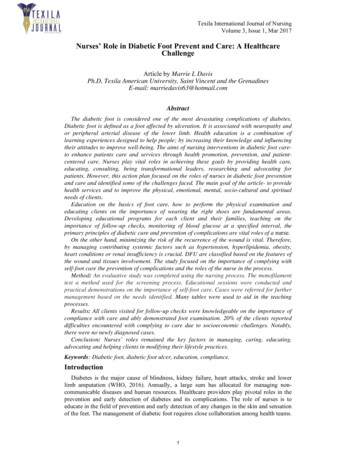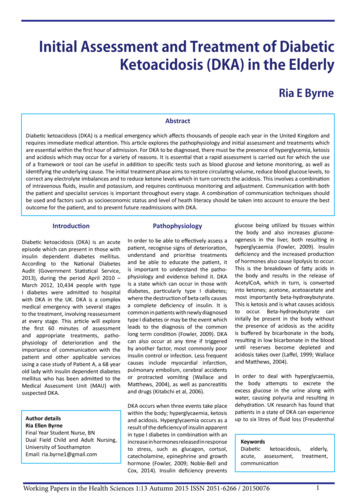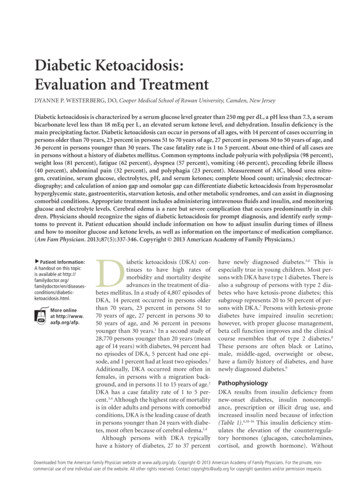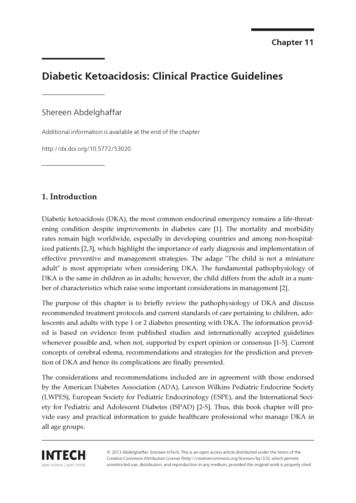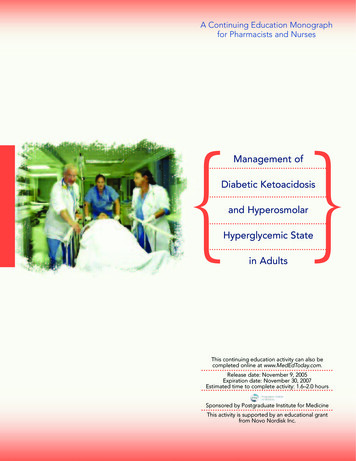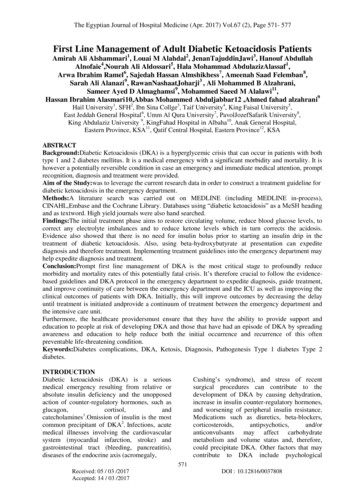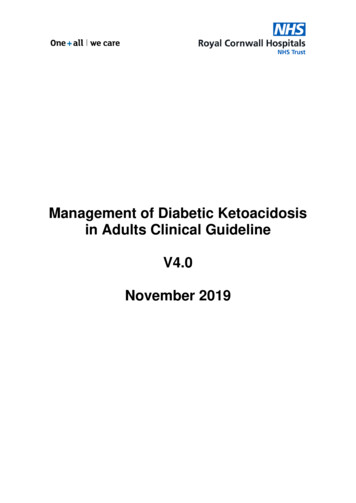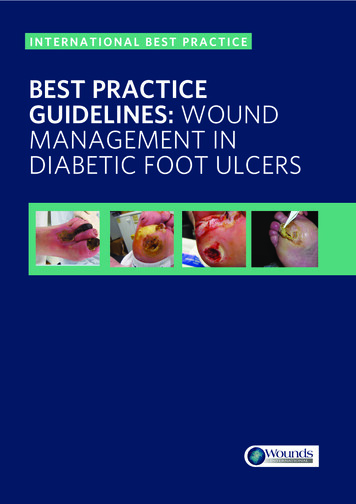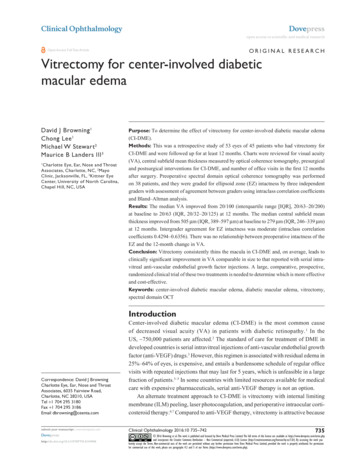
Transcription
Clinical OphthalmologyDovepressopen access to scientific and medical researchOriginal ResearchOpen Access Full Text ArticleVitrectomy for center-involved diabeticmacular edemaThis article was published in the following Dove Press journal:Clinical Ophthalmology26 April 2016Number of times this article has been viewedDavid J Browning 1Chong Lee 1Michael W Stewart 2Maurice B Landers III 3Charlotte Eye, Ear, Nose and ThroatAssociates, Charlotte, NC, 2MayoClinic, Jacksonville, FL, 3Kittner EyeCenter, University of North Carolina,Chapel Hill, NC, USA1Purpose: To determine the effect of vitrectomy for center-involved diabetic macular edema(CI-DME).Methods: This was a retrospective study of 53 eyes of 45 patients who had vitrectomy forCI-DME and were followed up for at least 12 months. Charts were reviewed for visual acuity(VA), central subfield mean thickness measured by optical coherence tomography, presurgicaland postsurgical interventions for CI-DME, and number of office visits in the first 12 monthsafter surgery. Preoperative spectral domain optical coherence tomography was performedon 38 patients, and they were graded for ellipsoid zone (EZ) intactness by three independentgraders with assessment of agreement between graders using intraclass correlation coefficientsand Bland–Altman analysis.Results: The median VA improved from 20/100 (interquartile range [IQR], 20/63–20/200)at baseline to 20/63 (IQR, 20/32–20/125) at 12 months. The median central subfield meanthickness improved from 505 µm (IQR, 389–597 µm) at baseline to 279 µm (IQR, 246–339 µm)at 12 months. Intergrader agreement for EZ intactness was moderate (intraclass correlationcoefficients 0.4294–0.6356). There was no relationship between preoperative intactness of theEZ and the 12-month change in VA.Conclusion: Vitrectomy consistently thins the macula in CI-DME and, on average, leads toclinically significant improvement in VA comparable in size to that reported with serial intravitreal anti-vascular endothelial growth factor injections. A large, comparative, prospective,randomized clinical trial of these two treatments is needed to determine which is more effectiveand cost-effective.Keywords: center-involved diabetic macular edema, diabetic macular edema, vitrectomy,spectral domain OCTIntroductionCorrespondence: David J BrowningCharlotte Eye, Ear, Nose and ThroatAssociates, 6035 Fairview Road,Charlotte, NC 28210, USATel 1 704 295 3180Fax 1 704 295 3186Email dbrowning@ceenta.comCenter-involved diabetic macular edema (CI-DME) is the most common causeof decreased visual acuity (VA) in patients with diabetic retinopathy. 1 In theUS, 750,000 patients are affected.2 The standard of care for treatment of DME indeveloped countries is serial intravitreal injections of anti-vascular endothelial growthfactor (anti-VEGF) drugs.3 However, this regimen is associated with residual edema in25%–64% of eyes, is expensive, and entails a burdensome schedule of regular officevisits with repeated injections that may last for 5 years, which is unfeasible in a largefraction of patients.3–5 In some countries with limited resources available for medicalcare with expensive pharmaceuticals, serial anti-VEGF therapy is not an option.An alternate treatment approach to CI-DME is vitrectomy with internal limitingmembrane (ILM) peeling, laser photocoagulation, and perioperative intraocular corticosteroid therapy.6,7 Compared to anti-VEGF therapy, vitrectomy is attractive because735submit your manuscript www.dovepress.comClinical Ophthalmology 2016:10 735–742Dovepress 2016 Browning et al. This work is published and licensed by Dove Medical Press Limited. The full terms of this license are available at https://www.dovepress.com/terms.phpand incorporate the Creative Commons Attribution – Non Commercial (unported, v3.0) License (http://creativecommons.org/licenses/by-nc/3.0/). By accessing the work youhereby accept the Terms. Non-commercial uses of the work are permitted without any further permission from Dove Medical Press Limited, provided the work is properly attributed. For permissionfor commercial use of this work, please see paragraphs 4.2 and 5 of our Terms i.org/10.2147/OPTH.S104906
DovepressBrowning et alit is potentially less expensive and is associated with a smallervisit burden with longer lasting effects. Unlike serial antiVEGF therapy, vitrectomy has never been examined in anadequately powered, prospective, randomized, controlledclinical trial. Many published retrospective case series,fewer prospective case series, and rare, small prospectiverandomized clinical trials using focal/grid laser as a controlarm show that vitrectomy thins the edematous macula butinconsistently improves VA.8,9We report a single-surgeon case series that adds to theevidence that, on average, VA and macular edema improveafter vitrectomy. We also examine whether preoperative intactness of the ellipsoid zone (EZ) line on spectral domain opticalcoherence tomography (SD-OCT) predicts the VA outcome.MethodsA retrospective chart review was performed on all patientswho underwent vitrectomy for CI-DME between May 2005and May 2014 by one surgeon (DJB) in a private retinapractice setting. Presence of a cataract was not an exclusioncriterion as long as the view to the fundus was adequate toperform vitreoretinal surgery. An exclusion criterion wasfollow-up for 1 year. The primary outcomes were changein corrected ETDRS VA with spectacles and pinhole at12 months and change in central subfield thickness at12 months. Secondary outcomes included the frequency ofpostoperative cataract surgery, interventions for refractoryor recurrent CI-DME, and number of office visits in the first12 months after surgery.A subset of 38 eyes (69%) had SD-OCT studies performedpreoperatively. For these patients, intactness of the EZ wasindependently graded by three retina specialists (DJB, MWS,and MBL) in a masked fashion. The grade assigned was thepercentage of EZ that was intact within 500 μm of the foveaon a horizontal SD-OCT scan through the fovea obtained atthe preoperative visit. Scans were performed on either a ZeissCirrus (Carl Zeiss Meditec AG, Jena, Germany) or a Heidelberg Spectralis (Heidelberg Engineering, Franklin, MA, USA)instrument. We converted all Spectralis measurements totheir equivalent values with the Cirrus instrument by adding19.3 μm to the Spectralis measurement, which was the averagedifference between Spectralis and Cirrus measurements foundby Lammer et al.10 Intergrader agreement was calculated usingintraclass correlation coefficients (ICCs) and Bland–Altmananalyses yielding mean difference in grades between gradersand the limits of agreement between graders. ICCs of 0–0.2indicate poor agreement, 0.3–0.4 indicate fair agreement,0.5–0.6 indicate moderate agreement, 0.7–0.8 indicate strong736submit your manuscript www.dovepress.comDovepressagreement, and 0.8 indicate almost perfect agreement. Therelationship of preoperative EZ status and VA outcome wasassessed by analysis of variance using the average of the threegrades of EZ intactness as the independent variable.The operative procedure was not identical for all patientsand varied according to retinal pathology and era duringwhich surgery was performed. All patients underwent vitrectomy with removal of the posterior hyaloid and performanceof panretinal photocoagulation of 1,000–1,500 spots. Allsurgeries were performed with 25 G instruments. Patientswith macular epiretinal membranes (ERMs) underwentpeeling of the membranes such that the foveal avascularzone was uninvolved after surgery. In the early years of theseries, the ILM was not peeled. In the later years, the ILMwas peeled after staining with indocyanine green (0.5 mg/mL,for 30 seconds). A circular area with a radius of 1–2 discdiameters from the fovea was peeled. Intravitreal injectionof corticosteroid was not performed in earlier cases. In latercases, intravitreal corticosteroid, initially as triamcinoloneacetonide, 4 mg, and later as a dexamethasone, 0.7 mg, slowrelease device, was used as an adjunct to surgery to decreaseearly postoperative inflammation.Descriptive statistics were computed with JMP 4.0software (SAS Institute Inc., Cary, NC, USA). ICCs andBland–Altman analyses were carried out with Medcalcsoftware 15.11.1 (Medcalc, Ostend, Belgium). Waiver ofboth informed consent and Health Insurance Portability andAccountability Act authorization for this retrospective studyof de-identified patient data were approved by the Presbyterian Hospital Institutional Review Board.ResultsFifty-three eyes of 45 patients who underwent vitrectomyfor CI-DME between 2005 and 2014 were analyzed. Themedian age of the patients was 66 years (interquartile range[IQR], 55–72 years), 19 (42%) were females, and 39 (87%)had type 2 diabetes. Other demographic characteristics ofthe patients are given in Table 1.Previous treatments for DME and diabetic retinopathywere common, although 18 eyes had received no treatmentfor DME before the vitrectomy. Thirty-five eyes had previoustreatments, which are detailed in Table 2.Preoperatively, 29 eyes (55%) were pseudophakic. As partof the vitrectomy (three eyes) or during the 12 months following vitrectomy (nine eyes), 12 eyes (23%) had un complicatedphacoemulsification cataract extraction with posterior chamber intraocular lens implantation. Twelve eyes (23%) werephakic at the 12-month end point.Clinical Ophthalmology 2016:10
DovepressVitrectomy for diabetic macular edemaTable 1 Demographic dataValueAge (years)Sex, F:MDiabetes type, 1:2Dialysis, Y:NHbA1c known, Y:NHbA1c (%) when knownEthnicityWhiteBlackSouth AsianEast AsianMiddle EasternDiastolic BP (mmHg)Systolic BP (mmHg)Mean arterial blood pressure (mmHg)Median 66, IQR (55–72)19:266:390:4519:26Median 7.2, IQR (6.6–8.0)37 (82.2%)3 (6.7%)2 (4.4%)2 (4.4%)1 (2.2%)Median 80, IQR (71–86)Median 138, IQR (124–150)Median 98, IQR (92–107)Note: Mean arterial blood pressure [systolic blood pressure 2 (diastolic bloodpressure)]/3.Abbreviations: IQR, interquartile range; F, female; M, male; Y, yes; N, no;HbA1C, hemo globin A1C; BP, blood pressure.The median VA improved from baseline (20/100; IQR,20/63–20/200) to 3 months, followed by stabilization to12 months (20/63; IQR, 20/32–20/125) (Figure 1). Themedian central subfield mean thickness (CSMT) followed asimilar course from baseline (505 µm; IQR, 389–597 µm)to 12 months (279 µm; IQR, 246–339 µm) (Figure 2).ERM peeling and ILM peeling were performed in 23 cases(43%) and 35 cases (66%), respectively. No intraocularcorticosteroid was used in eight cases (15%), whereas anintraoperative intravitreal triamcinolone acetonide 4 mgand an intraoperative dexamethasone implant (0.7 mg) wereused in 29 cases (55%) and 16 cases (30%), respectively.In univariate analysis of variance, peeling of the ILM wasassociated with a smaller 12-month improvement in thelogarithm of the minimum angle of resolution (logMAR) VA(P 0.0070), peeling of an ERM was associated with a largerimprovement in VA (P 0.0425), but the use of intraocularsteroids had no effect (P 0.8282) (Table 3). In a multivariateORJ0 5 YLVXDO DFXLW\ Characteristic 35161731811862101764065210210300000006 (1)08 (1), 12 (1), 19 (1)10 (1)01837365035Notes: *These data are formatted as number of treatments (number of patientsreceiving that number of treatments).Abbreviations: Focal, focal laser photocoagulation; grid, grid laser photocoagulation;bevacizumab, intravitreal bevacizumab; ranibizumab, intravitreal ranibizumab;triamcinolone, intravitreal triamcinolone; PRP, panretinal photocoagulation.Clinical Ophthalmology 2016:10 0RQWKV DIWHU YLWUHFWRP\Figure 1 Time course of response of the logMAR VA after vitrectomy for diabeticmacular edema.Abbreviations: % ile, percentile; logMAR, logarithm of the minimum angle ofresolution; VA, visual acuity.analysis, none of these three variables had a significant effecton 12-month change in VA (Table 3).There were no intraoperative complications in the 53cases reviewed and no secondary vitreoretinal surgeriesperformed in the 12 months following the vitrectomy forDME. The median number of office visits for the 12 monthsfollowing surgery was 7 (IQR, 5–9).Table 4 shows the reproducibility of the three graders forEZ intactness. The ICCs ranged from 0.4294 to 0.6356 ormoderate agreement among the three graders when assessedpairwise. The median grade of preoperative EZ intactnesswas 61% (IQR, 30%–93%). Figure 3 shows the relationshipof the 12-month change in logMAR VA as a function of thepreoperative intactness of EZ (mean of the three graders).No relationship was demonstrated either clinically or statistically (P 0.5641).&607 Focal/gridPRPBevacizumabRanibizumabTriamcinolone WK LOH Table 2 Previous treatments for diabetic retinopathyPrevious treatments Yes Number of indicated treatments Nofor diabetic1 2 3 4 5 Other*retinopathy0HGLDQ WK LOH 0HGLDQ WK LOH WK LOH 0RQWKV DIWHU YLWUHFWRP\Figure 2 Time course of response of the CSMT after vitrectomy for diabeticmacular edema.Abbreviations: % ile, percentile; CSMT, central subfield mean thickness.submit your manuscript www.dovepress.comDovepress737
DovepressBrowning et al(OOLSVRLG ]RQH LQWDFWQHVVTable 3 Effects of operative steps on 12-month change inlogMAR VAUnivariableanalysisMultivariableanalysisPeeling ILMPeeling ERMIntraocular steroid0.00700.04250.82820.07520.86840.7638Notes: Intraocular steroid: intraocular triamcinolone or dexamethasone sustainedrelease device. The cell entries are P-values of univariable (column 2) or multivariable(column 3) regression analyses of 12-month change in logMAR VA as a function ofone or more of the steps shown in column 1.Abbreviations: logMAR, logarithm of the minimum angle of resolution; VA, visualacuity; ILM, internal limiting membrane; ERM, epiretinal membrane.The median follow-up was 37.4 months (IQR, 15.6–58.8).During the postoperative follow-up, 35 eyes (66%) receivedadditional treatment for persistent DME and 18 eyes (34%)received no additional treatment. Table 5 specifies the treatments given after vitrectomy for diabetic retinopathy.Case reportsCase 1A 53-year-old woman with type 2 diabetes mellitus and systemic arterial hypertension had VA of 20/800 and CSMT of1,183 µm in her right eye. The eye had neovascularization ofthe disk, preretinal hemorrhage, and severe macular edemawith subretinal fluid (Figure 4). The eye had previously undergone focal laser photocoagulation and an intravitreal injection of bevacizumab with little response. The preoperativeSD-OCT showed loss of the EZ (Figure 4). Vitrectomy, ILMpeeling, panretinal laser photocoagulation, and intraocularinjection of a dexamethasone implant (0.7 mg) were performed. At 12 months follow-up, her VA had improved to20/70 and her CSMT had decreased to 246 µm. The 12-monthSD-OCT showed persistent loss of the EZ (Figure 4).Case 2A 50-year-old woman with type 2 diabetes mellitus for16 years had VA of 20/63 and CSMT of 712 µm in herTable 4 Reproducibility of graders for EZ intactnessGradercomparisonICC95% CIMeandifferenceLimits ofagreement1 versus 21 versus 32 versus 30.58030.63560.4294(0.3243, 0.7573)(0.2464, 0.8219)(0.0599, 0.6793)0.05( 0.68, 0.78)( 0.79, 0.37)( 0.95, 0.44) 0.21 0.25Notes: Mean difference represents the mean of the differences of the graders’scores indicated by the row label over the 38 eyes with preoperative spectraldomain optical coherence tomographs. Limits of agreement are the mean differenceplus and minus 1.96 times the standard deviation of the differences of the graders’scores indicated by the row label over the 38 eyes with preoperative spectraldomain optical coherence tomographs.Abbreviations: EZ, ellipsoid zone; ICC, intraclass correlation coefficient.738submit your manuscript www.dovepress.comDovepress PRQWK FKDQJH LQORJ0 5 9 Intraoperativestep Figure 3 Graph of 12-month change in logMAR VA after vitrectomy for diabeticmacular edema versus the intactness of the EZ assessed as the average of threescores by independent graders.Notes: The black line is the least-squares regression line. The slope does not differfrom zero to a statistically significant extent (P 0.5641).Abbreviations: logMAR, logarithm of the minimum angle of resolution; VA, visualacuity; EZ, ellipsoid zone.left eye. She had neovascularization of the disc and severemacular edema with subretinal fluid (Figure 5). She had previously undergone an intravitreal injection of bevacizumabwith little response. The preoperative SD-OCT showed lossof the EZ (Figure 5). Vitrectomy, ILM peeling, panretinallaser photocoagulation, and an intraocular injection of adexamethasone implant (0.7 mg) were performed. Her12-month postoperative VA remained 20/63, and her CSMThad decreased to 280 µm. The 12-month SD-OCT showedpersistent loss of the EZ (Figure 5).DiscussionThe major results of this study were that vitrectomy consistently improves center-involving DME and that the median12-month postvitrectomy VA improves by 0.20 logMAR(equivalent to ten ETDRS letters or two lines of VA on anETDRS chart). The anatomic results agree with almost allprevious reports, which have consistently shown thinning ofTable 5 Postvitrectomy treatments for diabetic retinopathyPostvitrectomytreatments fordiabetic riamcinoloneDexamethasonesustained release device12611232Number of 0100006 (1)25 (1)0No414742515051Notes: *These data are formatted as number of treatments (number of patientsreceiving that number of treatments).Abbreviations: Focal, focal laser photocoagulation; grid, grid laser photocoagulation;bevacizumab, intravitreal bevacizumab; ranibizumab, intravitreal ranibizumab;triamcinolone, intravitreal triamcinolone; PRP, panretinal photocoagulation.Clinical Ophthalmology 2016:10
DovepressVitrectomy for diabetic macular edema %&'7 617 ,61,Figure 4 Multimodal imaging of patient described in case 1.Notes: (A) Monochromatic fundus photograph of the right eye of the patient described in case 1. (B) Late phase frame of the fluorescein angiogram of the right eye ofthe patient described in case 1. The yellow arrow indicates neovascularization elsewhere. The blue arrow indicates neovascularization of the disc. The pink arrow indicatespreretinal hemorrhage. (C) Preoperative SD-OCT of the right eye of the patient described in case 1. White arrow indicates submacular fluid. Green arrow indicates thephotoreceptor layer with an absent EZ line. (D) 12-month postvitrectomy SD-OCT. The red arrow indicates an absent EZ line.Abbreviations: SD-OCT, spectral domain optical coherence tomography; EZ, ellipsoid zone. %&'1 67,1 67,Figure 5 Multimodal imaging of patient described in case 2.Notes: (A) Monochromatic fundus photograph of the left eye of the patient described in case 2. (B) Late phase frame of the fluorescein angiogram. The green arrow indicatesprofuse leakage of fluorescein throughout the macula. (C) Preoperative SD-OCT scan of the left eye. The turquoise arrow indicates the photoreceptor layer with an absentEZ line. (D) 12-month postvitrectomy SD-OCT. The red arrow indicates an absent EZ line. The yellow arrow indicates a nasal ERM that does not cover the fovea.Abbreviations: SD-OCT, spectral domain optical coherence tomography; EZ, ellipsoid zone; ERM, epiretinal membrane.Clinical Ophthalmology 2016:10submit your manuscript www.dovepress.comDovepress739
Browning et althe macula after vitrectomy surgery. The VA results agreewith some of the previously published reports11–15 but notothers.7,9,16–18 A meta-analysis of vitrectomy for DME concluded that vitrectomy offers neither structural nor functionalbenefits compared to focal/grid laser at 12 months follow-up,although only eleven of the hund
Center-involved diabetic macular edema (CI-DME) is the most common cause of decreased visual acuity (VA) in patients with diabetic retinopathy. 1 In the US, 750,000 patients are affected. 2 The .




